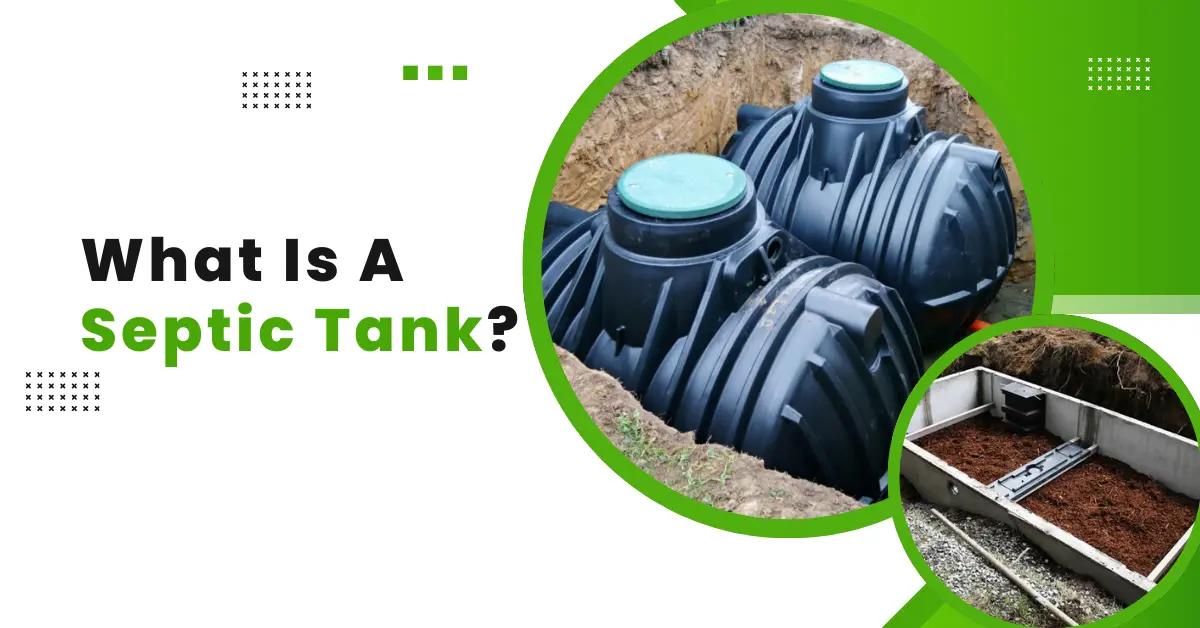Thinking about what septic tank size for 1 bedroom house? Whether you live in a tiny house, cabin, or small residence, the right septic tank size makes all the difference in performance and cost.
A 1-bedroom house usually requires a septic tank with a minimum capacity of 500 gallons. However, some jurisdictions may mandate 750 gallons to ensure future expansion or accommodate higher water use.
Nevertheless, tank size doesn’t depend on bedrooms alone.
This complete guide breaks down everything you need to know, from the key sizing factors like occupant count and water usage, to state code requirements, and costs.
Therefore, let’s get started!
Recommended Septic Tank Size for 1 Bedroom House
Choosing the right septic tank size for your 1-bedroom house involves planning for real-world usage, local regulations, and potential future changes.
Below, we break down the most commonly recommended tank sizes and explain when each one makes the most sense.
1. Quick Reference Table
| Notes | House Size | Recommended Tank Size |
| Seasonal use | 1 Bedroom | 300 – 500 gallons |
| Common standard | 1 Bedroom | 750 gallons |
| Best long-term choice | 1 Bedroom | 1,000 gallons |
| For high use and future-proof | 1 Bedroom | 1,250 – 1,500 gallons |
2. Minimum Size: 300-500 Gallons
When Is This Size Appropriate?
This size is suitable for seasonal cabins, weekend homes, or tiny houses with a single occupant.
It works best in situations with low daily water use, in general, under 50 gallons per day.
Risks and Drawbacks of Undersizing
- Frequent backups and system failures
- Higher maintenance and pumping costs
- Non-compliance with building codes and permits
3. The Standard Choice: 750 – 1,000 Gallons
Why This Size Is Most Common
This size is common because it fits 1-2 people with an average water use (about 75-100 gallons per day).
It offers a good balance of cost, space, and performance.
Advantages
- Adequate capacity for everyday use and occasional guests
- Readily available tank sizes and materials
Why This Is Most Recommended
- Handles daily wastewater for 1-2 people (about 50-100 gallons each).
- Offers extra room for guests or occasional water spikes.
- Meets local code minimums for residential systems (often 1,000 gallons).
Meets Most State Codes and Allows for Flexibility
Many states or cities set a 1,000-gallon minimum for permanent homes. This helps with getting permits and clearing inspections.
4. Future-Proofing: 1,250-1,500 Gallons
Why Consider Oversizing?
To prepare for a growing family or more people, add rooms or rental space later, or handle high water use from appliances like jacuzzis and washers.
Benefits of a Larger Tank
- Accommodates Future Expansion
A larger tank can handle the extra use without needing a full system change later. It also helps avoid expensive upgrades in the future.
- Enhances Resale Value
Buyers often see a bigger septic system as a benefit, since it saves them from upgrades. It also makes your home more appealing in places with tight septic rules.
- Reduces Maintenance Frequency
Bigger tanks need pumping less often, which saves both time and money. They also handle sludge and scum better, making treatment more efficient.
- Handles High Water Usage
Great for homes with fancy fixtures like whirlpool tubs or appliances that use a lot of water. Also, a smart pick if you often have guests or your household size changes.
Considerations
Though it costs more at first, a larger tank can save money over time with less maintenance and higher resale value.
Just make sure your property has enough space for it.
Key Factors That Affect Septic Tank Sizing
Here’s a breakdown of what truly matters when sizing a septic tank for a 1-bedroom house.
1. Number of Occupants (Not Just Bedrooms)
Many septic guidelines base size on bedroom count as a proxy for occupancy, but actual usage depends on how many people live there.
This matters because more people mean more daily wastewater.
For example, a one-bedroom vacation rental might regularly host four or more guests, so a larger tank would be smarter than just going with the minimum size.
It’s always best to plan based on the highest expected number of occupants, not just who’s living there now.
2. Daily Water Usage
Wastewater output is tied directly to how much water your household uses every day.
The system’s ability to handle water efficiently depends largely on how a septic system works, including the way it processes, separates, and disperses wastewater through the tank and drain field.
A general way to estimate your septic system needs is to multiply the number of people by 100 gallons per person per day.
Example: 2 people × 100 gallons = 200 gallons per day.
However, this number can go up depending on your lifestyle.
Things like long showers, frequent laundry, or water-heavy hobbies and home businesses can increase daily water use.
3. Soil Type & Drain Field Conditions
Your septic system relies not just on the tank but also on the drain or leach field, which filters wastewater after solids settle.
The soil type and how quickly it absorbs water, known as the percolation rate, play a big role in system design.
Slow-draining soils like clay often need larger tanks and wider drain fields to prevent overflow, while sandy, well-drained soils can manage with smaller setups.
The location of the drain field also affects the system; areas with high water tables, rocky ground, or steep slopes usually require more complex and expensive installations.
It’s always a smart idea to get a perc test (soil test) or consult a septic engineer before moving forward.
4. Plumbing Fixtures & Appliances
Modern homes often need bigger septic tanks because they have more water-using fixtures.
Features like multiple toilets, large bathtubs or jacuzzis, garbage disposals, washing machines, and dishwashers can all increase the amount of wastewater produced.
These add to peak flow loads, meaning the system has to handle a lot of water at once. If the tank isn’t sized properly, it may overflow or fail to treat the waste effectively.
5. Potential Home Expansion Plans
Are you considering adding a second bedroom, renting your place on Airbnb, or building a home office or guest studio?
These changes will increase water usage, and your system needs to be ready for it.
Future-proofing with a larger tank now can save you thousands in upgrade costs later.
For example, if you currently have a 1-bedroom home but plan to add a guest house, choosing a 1,250 – 1,500 gallon tank from the start is a smart investment.
6. Local Codes & Permit Requirements
Septic tank requirements vary by region, and every area has its own rules for minimum tank sizes and installation standards.
A common guideline is that many states require at least a 1,000-gallon tank for residential homes, even for just one bedroom.
Before choosing a system, it’s essential to check with your local permit office or health department.
They can help you confirm the minimum tank size, required distances from wells and buildings, and how often the system must be pumped.
Taking these steps early helps ensure your system meets local codes and avoids future issues.
Local & National Code Requirements
National and local codes often define minimum tank sizes, system design, and installation practices.
These codes are designed to prevent public health risks and groundwater contamination.
EPA Guidelines
The U.S. Environmental Protection Agency (EPA) provides baseline standards in its Onsite Wastewater Treatment Systems Manual.
While not a binding code, these guidelines influence many state health and environmental departments.
The EPA recommends that septic systems be sized based on:
- Estimated daily flow
- Soil percolation rate
- Tank retention time (minimum of 48 hours)
For residential systems, a daily flow estimate of 150 gallons per bedroom is commonly used.
State & Local Codes (Examples)
Many state and municipal codes have specific minimum septic tank sizes.
| State/Region | 1-Bedroom House | Notes |
| Pennsylvania | 900 gallons | Regardless of the number of bedrooms. |
| Florida | 900 – 1,050 gallons | Depends on the square footage |
| Texas | 1,000 gallons | Minimum regardless of bedrooms |
| California | 750 gallons | Varies by county |
| New York | 1,000 gallons | Even for 1-bed homes |
Why a 1-Bedroom Doesn’t Always Mean a Small Tank?
Most building codes and health departments require at least two people per bedroom, which is why even a 1-bedroom home usually needs a septic tank similar in size to a 2-bedroom home.
Using the common formula, if two people use 75 to 100 gallons of water each day, that means they use approximately 150 to 200 gallons together every day.
Since systems are designed to hold about two days’ worth of flow, that means at least 400 gallons of capacity is needed.
To stay reliable and meet code, 1,000 gallons is typically the minimum tank size required.
Septic Tank Installation Costs by Size
Installing a septic tank is a significant investment, and tank size is one of the biggest factors affecting the total cost.
Tank Cost by Size (Materials Only)
Prices vary based on material (plastic, concrete, fiberglass). Concrete tanks are generally more durable but may cost more.
| Tank Size (Gallons) | Average Cost (USD) | Common Use Case |
| 300-500 gal | $500 – $900 | Seasonal cabins, limited-use homes |
| 750 gal | $700 – $1,200 | Small homes, 1 – 2 bedrooms |
| 1,000 gal | $900 – $1,500 | Standard for 3 – 4 bedroom homes |
| 1,250 gal | $1,200 – $1,800 | Larger homes, 4 – 5 bedrooms |
| 1,500 gal | $1,500 – $2,500 | Homes with 6+ bedrooms or high usage |
Full Installation Cost Breakdown
Costs can vary based on location, soil conditions, and local regulations.
| Component | Estimated Cost (USD) |
| Tank (as above) | $500 – $2,500 |
| Site Prep | $1,200 – $4,500 |
| Drain/Leach Field | $3,000 – $15,000 |
| Permits & Inspections | $400 – $2,000 |
| Perc Test | $700 – $2,000 |
| Labor & Materials | $1,500 – $4,000 |
| Total Estimate | $6,000 – $25,000+ |
Maintenance Costs by Tank Size
Regular maintenance is crucial to prevent system failures, which can be costly to repair.
| Tank Size (Gallons) | Pumping Frequency | Pumping Cost (USD) |
| 300-500 gal | Every 1-2 years | $250 – $400 |
| 750-1,000 gal | Every 3-5 years | $300 – $500 |
| 1,250-1,500 gal | Every 4-6 years | $400 – $600 |
Common Septic Tank Sizing Myths to Avoid
Here are the most common myths homeowners fall for, and the facts that break them.
Myth #1: “Smaller homes only need small tanks.”
Reality
A 1-bedroom house doesn’t always mean one person. Most building codes assume at least two occupants per bedroom.
This means even small homes generate enough wastewater to require a 750 – 1,000 gallon tank at minimum. Undersizing risks frequent backups, clogs, and faster tank failure.
Myth #2: “Just get the biggest tank possible.”
Reality
Oversizing a septic tank beyond what your household produces can lead to problems like improper bacterial breakdown of waste.
Wastewater sits too long, then it causes solids to build up unnecessarily and potentially leading to system imbalance. Choose a size that balances capacity with expected daily usage, future growth, and local code compliance.
For most 1-bedroom homes, a 1,000 – 1,250 gallon tank is ideal.
Myth #3: “Bigger tank = better system performance.”
Reality
While tank size matters, it’s not the only component of your septic system.
The drain field (or leach field) is equally important. Even the largest tank will fail if wastewater can’t properly drain and filter into the soil.
A well-sized tank with a poorly designed or undersized drain field will still result in costly backups and system failure.
Myth #4: “Septic tanks never need maintenance if sized correctly.”
Reality
Even the perfectly sized and installed septic tank requires regular pumping and inspections. Sizing helps manage volume and frequency of maintenance, but it doesn’t eliminate it.
Solids accumulate over time and need to be removed to prevent clogs and backups. Even a 1,500-gallon tank can overflow or fail if neglected.
Pump your tank every 3-5 years, based on usage and size. For small tanks or heavy use, it might be every 1-2 years.
Myth #5: “Plastic septic tanks are always worse than concrete.”
Reality
While concrete tanks are more durable and often preferred by inspectors, high-quality plastic (polyethylene) tanks are easier and cheaper to install, resistant to corrosion and cracking, and ideal for tight-access or off-grid installations.
However, plastic tanks must be properly anchored to avoid floating in areas with a high water table.
Septic Tank Size Calculator
To help homeowners and builders make the most informed decision, here are three expert-backed resources.
1. SepticTank.info
Designed for both homeowners and contractors, this calculator provides EPA-compliant recommendations based on various factors.
Inputs include several bedrooms, bathrooms, average daily occupancy, and regional considerations.
2. National Tank Outlet Guide
This comprehensive guide by a leading tank retailer offers a practical septic tank size chart by bedroom count and occupancy assumptions.
It’s particularly helpful if you’re comparing tank sizes and shopping for containers.
3. BestCalculators.org
This calculator estimates the suitable septic tank size based on inputs like the number of occupants, daily water usage, and local regulations.
4. Dzynity.com
This tool calculates septic tank size based on household size, daily water usage per person, and tank dimensions.
Inputs include the number of people, daily water usage, and tank dimensions (length, width, depth).
FAQs
1. What size septic tank is needed for a 1-bedroom house?
For a 1-bedroom house, the recommended septic tank size typically ranges between 750 and 1,000 gallons. Smaller tanks (300-500 gallons) may be allowed for seasonal use, but most guidelines suggest at least 750 gallons for safe wastewater management.
2. Is a 500-gallon septic tank big enough for a 1-bedroom home?
A 500-gallon septic tank may be adequate for limited-use cabins or tiny homes occupied part-time by 1 – 2 people. However, for full-time residences, this size is often considered too small, especially if modern plumbing fixtures and higher water usage are involved. Undersized tanks increase the risk of system overload and require more frequent pumping.
3. What are the pros and cons of small septic systems?
Small systems can work well for part-time living, but full-time homes usually need a 750 – 1,000 gallon tank to stay safe and functional.
Pros
- Cheaper to buy, install
- Great for tiny homes
- Good for seasonal use
- Needs less space
Cons
- Needs frequent pumping
- Not for many people
- May fail code checks
- Easily overloaded with use
4. What Happens If Your Septic Tank Is Too Small?
If your septic tank is too small, it fills quickly, needs frequent pumping, risks clogs or drain field failure, causes slow drains or backups, emits odors, and may fail inspections.
5. What’s the average water usage for a 1-bedroom home?
For a 1-bedroom household (typically 1-2 people),
- Average daily usage: 100 – 150 gallons per person per day
- Total daily use estimate: 200 – 300 gallons/day
- Monthly water usage: ~6,000 to 9,000 gallons/month
Final Verdict
When it comes to sizing a septic tank for a 1-bedroom house, the ideal range is 750 to 1,000 gallons.
This size meets most local code requirements, accommodates typical daily usage, and allows flexibility for occasional guests or future appliance upgrades.
While a 300 – 500 gallon tank might suffice for part-time cabins or tiny homes, you should go slightly bigger for peace of mind.
A 1,000 to 1,250 gallon tank helps prevent system overloads, reduces maintenance frequency, and improves long-term value.
Flush smart, live clean!






